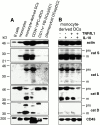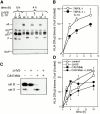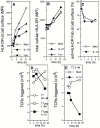Cytokines regulate proteolysis in major histocompatibility complex class II-dependent antigen presentation by dendritic cells
- PMID: 11304549
- PMCID: PMC2193402
- DOI: 10.1084/jem.193.8.881
Cytokines regulate proteolysis in major histocompatibility complex class II-dependent antigen presentation by dendritic cells
Abstract
Endo/lysosomal proteases control two key events in antigen (Ag) presentation: the degradation of protein Ag and the generation of peptide-receptive major histocompatibility complex (MHC) class II molecules. Here we show that the proinflammatory cytokines tumor necrosis factor alpha and interleukin (IL)-1beta rapidly increase the activity of cathepsin (cat) S and catB in human dendritic cells (DCs). As a consequence, a wave of MHC class II sodium dodecyl sulfate stable dimer formation ensues in a catS-dependent fashion. In contrast, the antiinflammatory cytokine IL-10 renders DCs incapable of upregulating catS and catB activity and in fact, attenuates the level of both enzymes. Suppressed catS and catB activity delays MHC class II sodium dodecyl sulfate stable dimer formation and impairs Ag degradation. In DCs exposed to tetanus toxoid, IL-10 accordingly reduces the number of MHC class II-peptide complexes accessible to tetanus toxoid-specific T cell receptors, as analyzed by measuring T cell receptor downregulation in Ag-specific T cell clones. Thus, the control of protease activity by pro- and antiinflammatory cytokines is an essential feature of the Ag presentation properties of DCs.
Figures











Similar articles
-
Proteases involved in MHC class II antigen presentation.Immunol Rev. 1999 Dec;172:109-20. doi: 10.1111/j.1600-065x.1999.tb01360.x. Immunol Rev. 1999. PMID: 10631941 Review.
-
Dendritic cells use macropinocytosis and the mannose receptor to concentrate macromolecules in the major histocompatibility complex class II compartment: downregulation by cytokines and bacterial products.J Exp Med. 1995 Aug 1;182(2):389-400. doi: 10.1084/jem.182.2.389. J Exp Med. 1995. PMID: 7629501 Free PMC article.
-
Selective induction of the secretion of cathepsins B and L by cytokines in synovial fibroblast-like cells.Br J Rheumatol. 1997 Jul;36(7):735-43. doi: 10.1093/rheumatology/36.7.735. Br J Rheumatol. 1997. PMID: 9255106
-
Novel physiological functions of cathepsins B and L on antigen processing and osteoclastic bone resorption.Adv Enzyme Regul. 1998;38:235-51. doi: 10.1016/s0065-2571(97)00021-6. Adv Enzyme Regul. 1998. PMID: 9762356
-
The role of lysosomal proteinases in MHC class II-mediated antigen processing and presentation.Immunol Rev. 1999 Dec;172:121-9. doi: 10.1111/j.1600-065x.1999.tb01361.x. Immunol Rev. 1999. PMID: 10631942 Review.
Cited by
-
Interaction Between Virus-Like Particles (VLPs) and Pattern Recognition Receptors (PRRs) From Dendritic Cells (DCs): Toward Better Engineering of VLPs.Front Immunol. 2020 Jun 9;11:1100. doi: 10.3389/fimmu.2020.01100. eCollection 2020. Front Immunol. 2020. PMID: 32582186 Free PMC article. Review.
-
Limited promiscuity of HLA-DRB1 presented peptides derived of blood coagulation factor VIII.PLoS One. 2013 Nov 14;8(11):e80239. doi: 10.1371/journal.pone.0080239. eCollection 2013. PLoS One. 2013. PMID: 24244658 Free PMC article.
-
Role of plasmacytoid dendritic cell subsets in allergic asthma.Allergy. 2013 Jun;68(6):695-701. doi: 10.1111/all.12166. Epub 2013 May 11. Allergy. 2013. PMID: 23662841 Free PMC article. Review.
-
Dissection of the dislocation pathway for type I membrane proteins with a new small molecule inhibitor, eeyarestatin.Mol Biol Cell. 2004 Apr;15(4):1635-46. doi: 10.1091/mbc.e03-07-0506. Epub 2004 Feb 6. Mol Biol Cell. 2004. PMID: 14767067 Free PMC article.
-
Visualization of the ER-to-cytosol dislocation reaction of a type I membrane protein.EMBO J. 2002 Mar 1;21(5):1041-53. doi: 10.1093/emboj/21.5.1041. EMBO J. 2002. PMID: 11867532 Free PMC article.
References
-
- Cella M., Engering A., Pinet V., Pieters J., Lanzavecchia A. Inflammatory stimuli induce accumulation of MHC class II complexes on dendritic cells. Nature. 1997;388:782–787. - PubMed
-
- Cella M., Sallusto F., Lanzavecchia A. Origin, maturation and antigen presenting function of dendritic cells. Curr. Opin. Immunol. 1997;9:10–16. - PubMed
-
- Banchereau J., Steinman R.M. Dendritic cells and the control of immunity. Nature. 1998;392:245–252. - PubMed
-
- Morel A.S., Quaratino S., Douek D.C., Londei M. Split activity of interleukin-10 on antigen capture and antigen presentation by human dendritic cellsdefinition of a maturative step. Eur. J. Immunol. 1997;27:26–34. - PubMed
-
- Villadangos J.A., Ploegh H.L. Proteolysis in MHC class II antigen presentationwho's in charge? Immunity. 2000;12:233–239. - PubMed
Publication types
MeSH terms
Substances
LinkOut - more resources
Full Text Sources
Other Literature Sources
Research Materials
Miscellaneous

